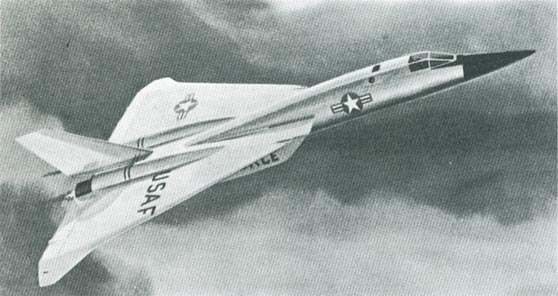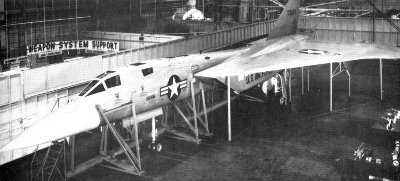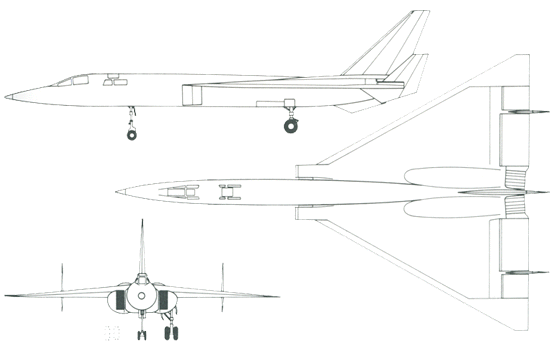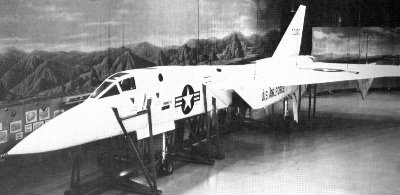


This Month in Aviation History
Aircraft of the Month for July 2001

North American (X)F-108 Rapier
by Alex Stoll
T |




T |

However, technology initially destined for the F-108 found its way into the F-12 interceptor program: the YF-12As used the Hughes AN/ASG-18 radar and the GAR-9 Falcon missile, redesignated AIM-47A in 1962. Although the F-12 program was also cancelled, some of the technology trickled into the F-14 program and the 160-km (100-mi) range AIM-54 Pheonix missile.

| Estimated North American (X)F-108 "Rapier" Secifications | |
| Type | High-speed high-altitude interceptor |
| Accomodation | pilot and radar operator in tandem |
| Powerplant | Two General Electric XJ93-GE-3AR turbojets, 92.9 kN (20,900 lb) thrust dry, 133.4 kN (30,000 lb) thrust with afterburning |
| Armament | Four 20mm cannons, 108 70mm (2.75 in) rockets and up to 1800 kg (4000 lbs) of bombs; three Hughes GAR-9 Falcon missiles in an internal weapons bay |
| Performance | |
|---|---|
| Max speed | 3190 km/h (1720 kts/1980 mph) at 23,340 m (76,550 feet) |
| Service ceiling | 24,425 m (80,100 ft) |
| Combat ceiling | 23,340 m (76,550 feet) |
| Time to climb to 15,250 m (50,000 ft) | 5.4 minutes |
| Initial rate of climb | 5,490 m (18,000 ft) per minute |
| Combat radius | 1640 km (886 nm/1020 mi) with three missiles |
| Ferry range | 4610 km (2488 nm/2860 mi) |
| Weights | |
| Empty | 23,112 kg (50,907 lb) |
| Combat | 34,558 kg (50,907 lb) |
| MTOW | 46,559 kg (102,533 lb) |
| Dimensions | |
| Wingspan | 17.51 m (57 ft 5 in) |
| Length | 27.19 m (89 ft 2 in) |
| Height | 6.73m (22 ft 1 in) |
| Wing area | 576.6 m² (1865 sq ft) |

|
2 July 1970 - First flight of two-seat Viggen prototype 2 July 1959 - First flight of Kaman K-20 (H-2) 4 July 1986 - First flight of Rafale A 4 July 1993 - First flight of the T-3 5 July 1969 - First flight of J-8 prototype 6 July 1972 - First flight of the MFI-17 Supporter 7 July 1973 - First flight of TF-15 (later F-15B) 7 July 1962 - First flight of Lockheed XV-4A Hummingbird 8 July 1948 - First flight of Il-28 prototype 8 July 1975 - First flight of the Shorts 330 production prototype 7 July 1990 - First high-speed taxi tests of YF-23 11 July 1969 - First flight of the MFI-15 12 July 1980 - First flight of the KC-10 13 July 1986 - First flight of the PZL-130 Turbo Orlik (with a PT6) 14 July 1955 - First flight of XP6M-1 prototype 15 July 1937 - First flight of Ha 138 (BV 138) prototype 16 July 1965 - First flight of the first YOV-10A 16 July 1998 - First flight of the T-6A Texan II 17 July 1939 - First flight of the Beaufighter |
17 July 1978 - First flight of the Soko Super Galeb prototype 17 July 1989 - First flight of B-2 20 July 1951 - First flight of P.1067 Hunter prototype 20 July 1958 - First flight of a P.531 prototype 20 July 1971 - First flight of the first Mitsubishi XT-2 22 July 1956 - First flight of production Javelin 23 July 1971 - First flight of Nomad N2 prototype 24 July 1956 - First flight of Etendard IV 25 July 1996 - Nimrod 2000 (MRA4) selected to replace Nimrod 26 July 1940 - First flight of a Merlin-powered Beaufighter 26 July 1957 - First flight of BR.1001 Taon 27 July 1972 - First flight of the first development F-15 27 July 1983 - First flight of EMB-120 29 July 1954 - First flight of the MS-760-01 29 July 1981 - First flight of XT-4 prototype 30 July 1954 - First flight of YF9F-9 (F-11 prototype) 30 July 1959 - First flight of N-156 30 July 1976 - First flight of Kiran Mk II
Click here to see a list of links to past Aircraft of the Months, sign or view the guestbook, see the counter, visit my home page, or view the Forum.
From www.geocities.com/strekoz
|